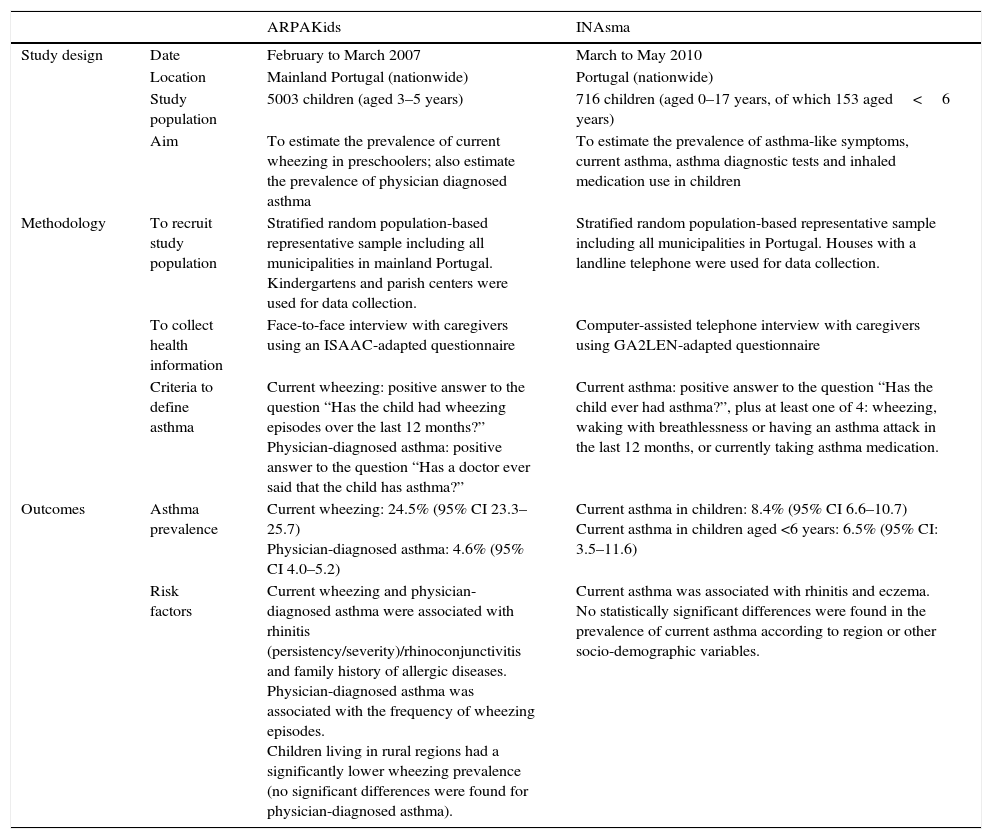We read with interest the research letter “Asthma prevalence in Portuguese preschool children: The latest scientific evidence”, published by Branco et al.1 The authors intended to review the major findings of published papers on childhood asthma prevalence in preschool-aged children in our country. We agree with the authors that it is important to have nationwide-based surveys, so we would like to briefly cite two large surveys that were published by our group, and that can contribute to the knowledge about asthma and recurrent wheezing in the same age group (Table 1).2,3
Comparison of the main characteristics of the nationwide studies analysis asthma prevalence in pre-school children.
| ARPAKids | INAsma | ||
|---|---|---|---|
| Study design | Date | February to March 2007 | March to May 2010 |
| Location | Mainland Portugal (nationwide) | Portugal (nationwide) | |
| Study population | 5003 children (aged 3–5 years) | 716 children (aged 0–17 years, of which 153 aged<6 years) | |
| Aim | To estimate the prevalence of current wheezing in preschoolers; also estimate the prevalence of physician diagnosed asthma | To estimate the prevalence of asthma-like symptoms, current asthma, asthma diagnostic tests and inhaled medication use in children | |
| Methodology | To recruit study population | Stratified random population-based representative sample including all municipalities in mainland Portugal. Kindergartens and parish centers were used for data collection. | Stratified random population-based representative sample including all municipalities in Portugal. Houses with a landline telephone were used for data collection. |
| To collect health information | Face-to-face interview with caregivers using an ISAAC-adapted questionnaire | Computer-assisted telephone interview with caregivers using GA2LEN-adapted questionnaire | |
| Criteria to define asthma | Current wheezing: positive answer to the question “Has the child had wheezing episodes over the last 12 months?” Physician-diagnosed asthma: positive answer to the question “Has a doctor ever said that the child has asthma?” | Current asthma: positive answer to the question “Has the child ever had asthma?”, plus at least one of 4: wheezing, waking with breathlessness or having an asthma attack in the last 12 months, or currently taking asthma medication. | |
| Outcomes | Asthma prevalence | Current wheezing: 24.5% (95% CI 23.3–25.7) Physician-diagnosed asthma: 4.6% (95% CI 4.0–5.2) | Current asthma in children: 8.4% (95% CI 6.6–10.7) Current asthma in children aged <6 years: 6.5% (95% CI: 3.5–11.6) |
| Risk factors | Current wheezing and physician-diagnosed asthma were associated with rhinitis (persistency/severity)/rhinoconjunctivitis and family history of allergic diseases. Physician-diagnosed asthma was associated with the frequency of wheezing episodes. Children living in rural regions had a significantly lower wheezing prevalence (no significant differences were found for physician-diagnosed asthma). | Current asthma was associated with rhinitis and eczema. No statistically significant differences were found in the prevalence of current asthma according to region or other socio-demographic variables. | |
95% CI–95% confidence intervals.
The first survey was a cross-sectional, questionnaire-based (ISAAC-adapted) descriptive study of children aged between 3 and 5 years living in mainland Portugal (ARPAkids); a representative sample of 5003 children was included in the analysis.2
The prevalence of “wheezing in the last 12 months” (current wheezing – CW) was 24.5% [95% confidence interval (CI) 23.3–25.7]; most of these children (61.4%) had had 1–3 wheezing episodes in the previous year, and 7.5% reported >12 episodes. The prevalence of CW was significantly higher in children with a family history of allergic disease; those living in rural regions had a significantly lower wheezing prevalence. No statistically significant differences were found for gender, age, birth weight, or exposure to tobacco smoke at home. The prevalence of “physician diagnosed asthma” (PDA) in children with CW was 16.7% [95% CI 14.6–18.8] – vs. 4.6% [95% CI 4.0–5.2] in the general population; it was highest (73.0%) in those with >12 wheezing episodes.
CW was strongly associated with rhinitis in this age group, especially with moderate – severe persistent disease; children with both wheezing and rhinitis had more wheezing episodes and needed treatment more frequently. The number of wheezing episodes significantly increased with increasing rhinitis severity/persistency.2,4
The second survey included the paediatric-specific data (n=716; 21.4% younger than 6 years of age) from a cross-sectional, population-based, all-age, nationwide telephone interview study (INAsma), the first population-based epidemiological study aiming to estimate asthma prevalence in Portugal covering all ages.3 The methodology of this study has been previously described5; a GA2LEN-adapted questionnaire was used. “Current asthma” (CA) was defined as a positive answer to “has the child ever had asthma?”, plus at least one of 4: wheezing, waking with breathlessness or having had an asthma attack in the previous 12 months, or currently taking asthma medication.
In children aged <6 years, the prevalence of CW and CA was 31.0% (95% CI 24.4–38.5) and 6.5% (95% CI 3.5–11.6), respectively. No statistically significant differences were found in the prevalence of CA according to region or other socio-demographic variables, but a higher risk for CA was found in children with rhinitis and eczema.3
In conclusion, asthma-like symptoms were present in one-third to one-fourth of Portuguese preschool children; the prevalence of PDA was 4.6% (ARPAkids) and of CA was 6.5% (INAsma). Asthma prevalence can vary significantly according to different study methodologies, namely disease definition, and objective markers of disease must be included in future surveys.
Conflicts of interestThe authors have no conflicts of interest to declare.







